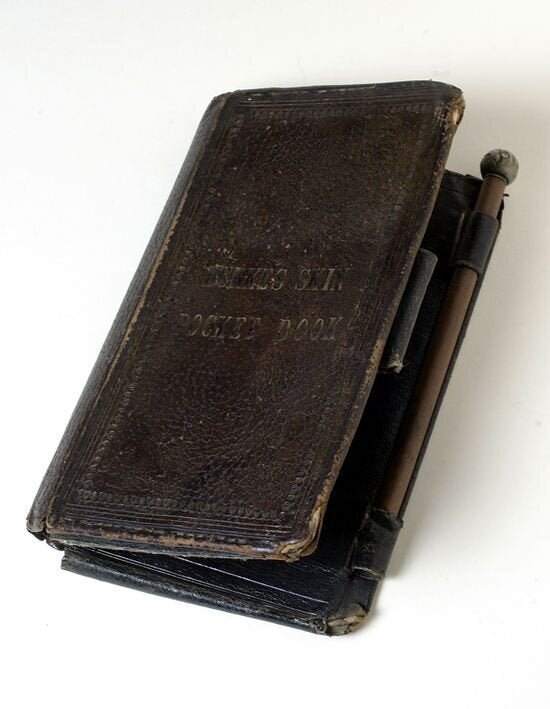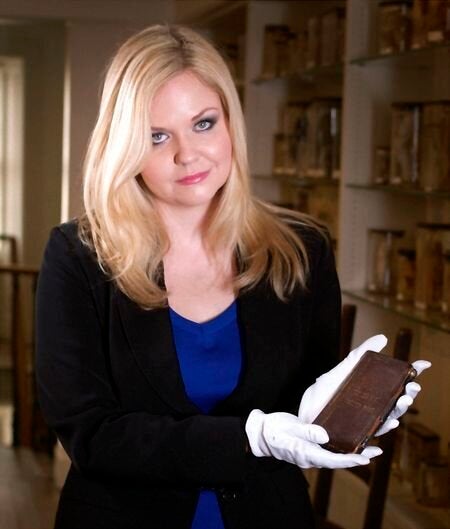
It is hot and muggy in the upstairs gallery of Surgeons' Hall in Edinburgh. I walk past shelves upon shelves of jars that contain 18th-century specimens suspended in liquid: a severed spine here, a cancerous bowel there. Compared with the lower level of the museum, it is eerily quiet up here. This section is not open to the public and so these objects are rarely gazed upon with such naked curiosity as I am experiencing now.
In this instance, I am not Dr Lindsey Fitzharris, medical historian. I am as inquisitive as any person who would be granted access to the collection up here, bubbling over with questions and observations about the bits of body parts floating before my eyes. But before I can seek answers to these questions, I must first view the object I've come to film for my upcoming television documentary, Medicine's Dark Secrets: a pocketbook bound in the skin of the 19th-century murderer, William Burke.
I make my way to the end of the gallery where the Director of Heritage, Chris Henry, is standing, along with my film crew. In his gloved hand, he holds the notorious pocketbook which has attracted tourists from around the world to Surgeons' Hall for decades. I have never seen it outside of a glass case. It looks less "sacred" without the dim spotlights and laminated cards describing its origins.
It looks almost normal.
But of course, it isn't normal. Far from it. In 1828, William Burke and William Hare murdered 16 people over the course of 10 months. Masquerading as bodysnatchers, the two murderers then sold the fresh corpses onto surgeons in Edinburgh where the bodies were then dissected in private anatomy schools dotted around the city.
Burke and Hare were eventually apprehended when one of their victims was discovered in the dissection room of Dr Robert Knox, who had been purchasing many of the suspiciously fresh bodies from the two men over the past several months. Hare turned King's evidence and was released, while Burke took the blame and was sentenced to death. What awaited him at the end of the rope was much worse than even he could imagine.
Chris hands me a pair of white gloves just before we begin rolling. He's an expert on this object, so the interview flows easily. He regales the film crew and me with stories about how it came into existence, telling us that Burke's body was privately dissected as a mob of several hundred people gathered outside the surgeons' window demanding to be let in.
As Chris speaks, it suddenly happens. He hands me the pocketbook, almost as if he is handing me any book from a library shelf. I can't feel it in the same way I would if I wasn't wearing gloves, but I have a visceral reaction to the object nonetheless. This is the actual skin of a notorious murderer--a man I had been reading about for years in my own research.

This is the closest I will ever get to Burke's physical self. It's as if I've reached out and touched his arm, which of course I just may have given the material this object is made from.
After my initial reaction, I begin inspecting the pocketbook more carefully. It is remarkably well preserved considering this was meant to be a functioning item. Indeed, the original pencil that came with the pocketbook is still tucked neatly inside its covers. Looking at it, I can hardly believe someone would use it to carry money. Even for me--the Queen of Macabre--this is all a bit too much.
Its covers are soft and pliable after all these years, reminding me that this was indeed used on a regular basis. In faded gold letters, the front reads: BURKE'S SKIN POCKET BOOK. When I turn it over in my hands, the words--EXECUTED 28 JAN 1829--complete the story.
Emma Black, who heads public engagement at the museum, talks to me off camera about the pocketbook. As with any museum containing human specimens, Surgeons' Hall has several pieces on display that are controversial. Interestingly, Burke's skin book isn't often mentioned as one of them. She wonders if, given the atrocity of the crimes committed, some of us have come to accept that this object is suitable for display. At the time, the dissection and book acted as a further punishment for Burke's crimes and was seen as a form of justice which fitted the horrific nature of the murders themselves.
For me, however, the pocketbook is much more than this. It represents the growing need for bodies in the dissection room at the beginning of the 19th century, and the willingness by some anatomists to turn a blind eye to the dubious doings of those who procured the dead on their behalf.
In short, the pocketbook represents a dark and sordid part of our medical history.
After several minutes, I hand the pocketbook back to Emma. Once more back in its case, the object takes on that "sacred" glow.
For more medical history tales, check out The Chirurgeon's Apprentice. Medicine's Dark Secrets is currently being filmed byBig Baby Productions Ltd.